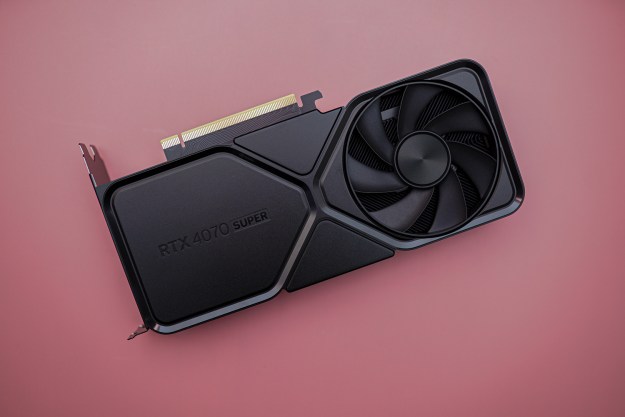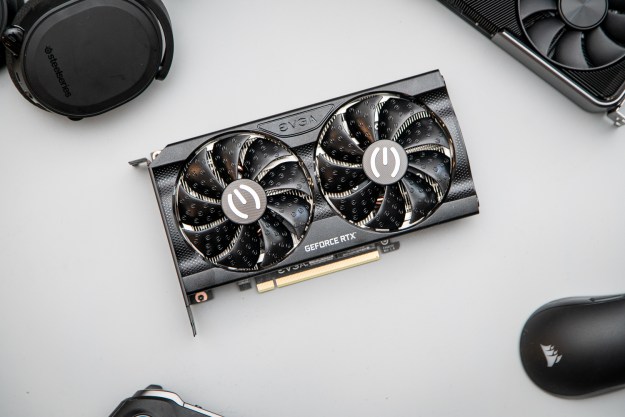The RTX 3080 Ti and 3070 Ti add some updates to Nvidia’s wildly popular Ampere range. On paper, though, the 3070 Ti doesn’t look much different than the base 3070. It comes with more cores and a slight clock speed boost, but it’s not quite the improvement we expected from Nvidia.
Is upgrading from an RTX 3070 to an RTX 3070 Ti worth it? Or should you spend a little more and go for the 3080? We rounded up the RTX 3070 Ti, 3080, and 3070 to compare them and find out which is the best graphics card to pick up in 2021.
Pricing and availability

Nvidia announced the RTX 3070 and 3080 on September 1, 2020, and the 3080 released on September 17 for $699 and the 3070 released on October 29 for $499. The 3070 Ti arrived shortly after the 3080 Ti on June 10, 2021, for $599.
Those prices don’t mean much. Right now, the RTX 3070 is selling for around $1,300 on the secondhand market, while the 3080 often sells for $2,000. Even if you’re lucky enough to score one of these cards from the source, you’ll pay far above MSRP. Retailers sell RTX 3070 models for around $700 to $800, and the 3080 often goes for above $1,000.
That’s because of the ongoing GPU shortage. Disruptions in manufacturing supply chains, increased demand from cryptocurrency miners, and tariffs on cards imported from China have all contributed to low supply and high demand, which leads to one thing — insanely high prices. Frankly, none of the cards are worth their secondhand price, and there’s an argument that they’re not worth their retail price, either.
Between the three, the RTX 3070 is the best value. At around $700, the 3070 is cheap enough that you’re not just throwing away money. But how much you pay is going to come down to which cards you find in stock, and at what price.
Specs and performance

As the RTX 3080 Ti has shown, balance is becoming an issue in the Ampere range. The RTX 3070 Ti only complicates matters more. It’s a marginal upgrade across the board, showing modest gains over the RTX 3070 while still lagging way behind the specs of the RTX 3080. And with an extra $100 on the line — or likely much more given the GPU market — the RTX 3070 Ti doesn’t do enough to set itself apart.
| RTX 3070 Ti | RTX 3080 | RTX 3070 | |
| GPU | GA104-400-A1 | GA102-200-KD-A1 | GA104-300-A1 |
| Interface | PCIe 4.0 | PCIe 4.0 | PCIe 4.0 |
| CUDA cores | 6,144 | 8,704 | 5,888 |
| Tensor cores | 192 | 272 | 184 |
| RT cores | 48 | 68 | 46 |
| Base clock | 1,575MHz | 1,440MHz | 1,500MHz |
| Boost clock | 1,770MHz | 1,710MHz | 1,725MHz |
| Memory | 8GB GDDR6X | 10GB GDDR6X | 8GB GDDR6 |
| Memory speed | 1,188MHz | 1,188MHz | 1,750MHz |
| Bandwidth | 608GBps | 760GBps | 448GBps |
| Memory bus | 256-bit | 320-bit | 256-bit |
| TDP | 290W | 320W | 220W |
Let’s start with the marginal improvements. The 3070 Ti comes with 256 more CUDA cores, eight more Tensor cores, and two more RT cores compared to the base 3070. It also has a slight clock boost, which comes out in the wash with a little GPU overclocking. The biggest improvement is in memory. Although the 3070 Ti still comes with 8GB, it uses GDDR6X memory, which is able to achieve much higher bandwidth on the same 256-bit bus.
Specs don’t tell the full story, but they do offer a synopsis. The 3070 Ti does very little to stand apart from the 3070. It’s certainly a more powerful card, but you shouldn’t jump at selling your RTX 3070 thinking you’ll get a significant upgrade.
Early benchmarks show that. Across a suite of synthetic tools, the 3070 Ti offers up to a 10% increase in performance over the 3070, and that gap shows up in games, too. For context, the RTX 3080 was able to achieve up to 40% higher performance in the same benchmark suite.
Across the board, the RTX 3080 destroys the other two cards. A quick look at the spec sheet shows that, and our real-world testing confirms it. The 3080 is a 4K powerhouse capable of delivering above 60 frames per second (fps) in demanding AAA games like Assassin’s Creed Odyssey and Battlefield V. The 3070 and 3070 Ti can run these games at 4K, but you’ll need to step down to 1440p to see similar frame rates.
The real question is if 10% is worth $100 or more. Given Nvidia’s pricing, the 3070 Ti should perform about 20% above the 3070 and 20% below the 3080, and that’s not the case. In this three-way battle, there are really only two options. If you already have an RTX 3070 and want to upgrade, go with an RTX 3080. If you don’t have a card yet and you’re deciding between the three, it comes down to the 3070 and the 3080.
That’s assuming you’ll spend the same price for the 3070 and 3070 Ti, though. If the difference between them is $100 or more — it’s hard to tell with secondhand prices constantly fluctuating — you can either save some money with the 3070 or spend a little more for the 3080.
LHR and ray tracing

One of the reasons Nvidia’s graphics cards are so expensive is cryptocurrency mining demand. Thankfully, Nvidia has a solution. The RTX 3070 Ti, 3070, and 3080 all come with the Lite Hash Rate (LHR) GPU core. This GPU core delivers identical performance while limiting the Ethereum hash rate, which should help lower demand from miners. If you’re a miner yourself, you might want to consider a card from AMD instead.
All three cards also come with Nvidia’s RTX features. The first part of the RTX package is hardware-accelerated ray tracing. Each of the cards use dedicated ray tracing cores to render reflections and shadows at the photon level, adding a new level of realism to supported games.
The problem is that ray tracing is extremely demanding, which is where the other RTX feature — deep learning super sampling (DLSS) — comes into play. DLSS uses A.I. to upscale games from a low-resolution internal render. Instead of rendering a game at 4K, for example, DLSS renders the game at 1080p and upscales it to 4K without much loss in image quality.
The RTX package is one of the main reasons to buy an Nvidia card instead of an AMD one. And thankfully, all three of our competitors deliver them.
Two real options

This comparison really comes down to the RTX 3080 versus one of the 3070. Between the 3070 and 3070 Ti, the extra cost of the Ti variant isn’t worth it. You may, however, find the two cards for around the same price, and in that case, the 3070 Ti is a slightly more powerful card.
Under normal circumstances, the 3070 Ti would be an unnecessary addition to the Ampere lineup. It delivers a little extra performance, but nothing that justifies its price tag. These aren’t normal circumstances, though. If there’s anything the 3070 Ti does well, it’s delivering more cards to the market, and that’s what matters right now. We just don’t recommend paying a significant premium for the 3070 Ti over the 3070.
The 3080 complicates things a bit. It’s the best card of the lot by a significant margin, but it also sells for much more. If you can find one reasonably priced — under or around $1,000 at this point — it’s the best option.
Editors' Recommendations
- Nvidia could flip the script on the RTX 5090
- You shouldn’t buy these Nvidia GPUs right now
- Nvidia DLSS is amazing, but only if you use it the right way
- Nvidia is the ‘GPU cartel,’ says former AMD Radeon manager
- Using an RTX 3060? Here’s the GPU to upgrade to next




